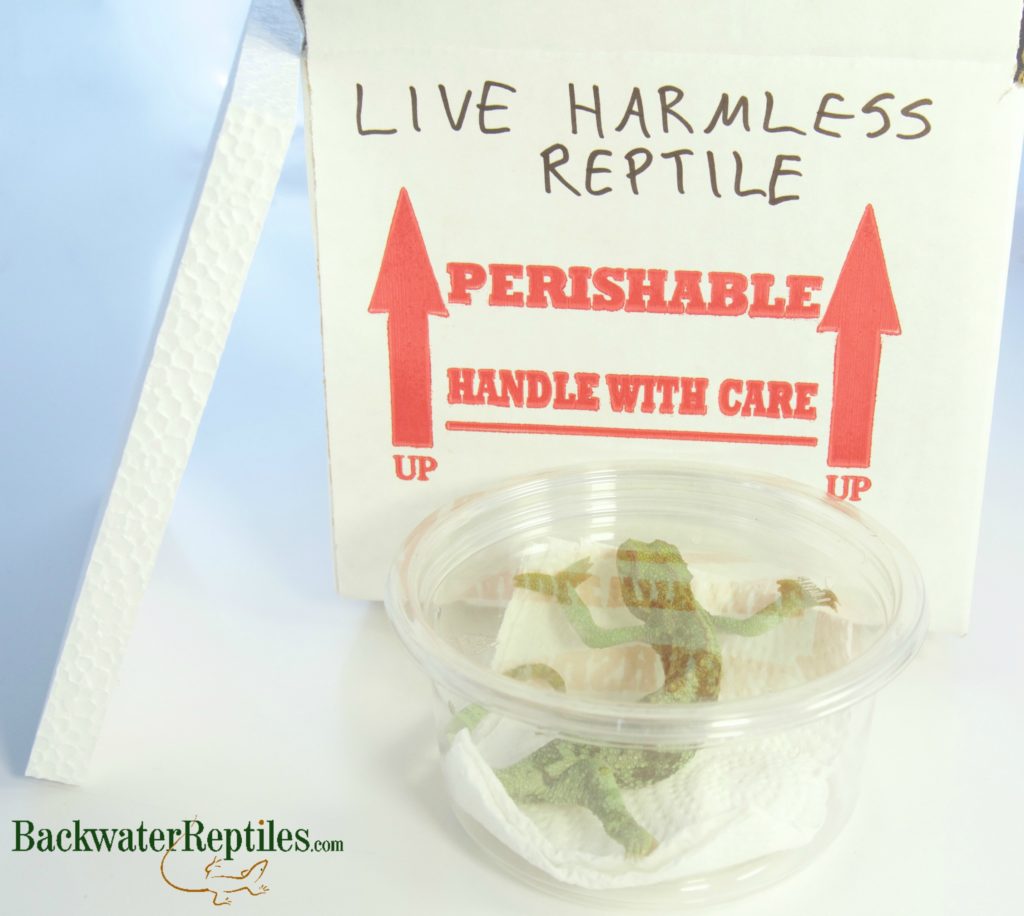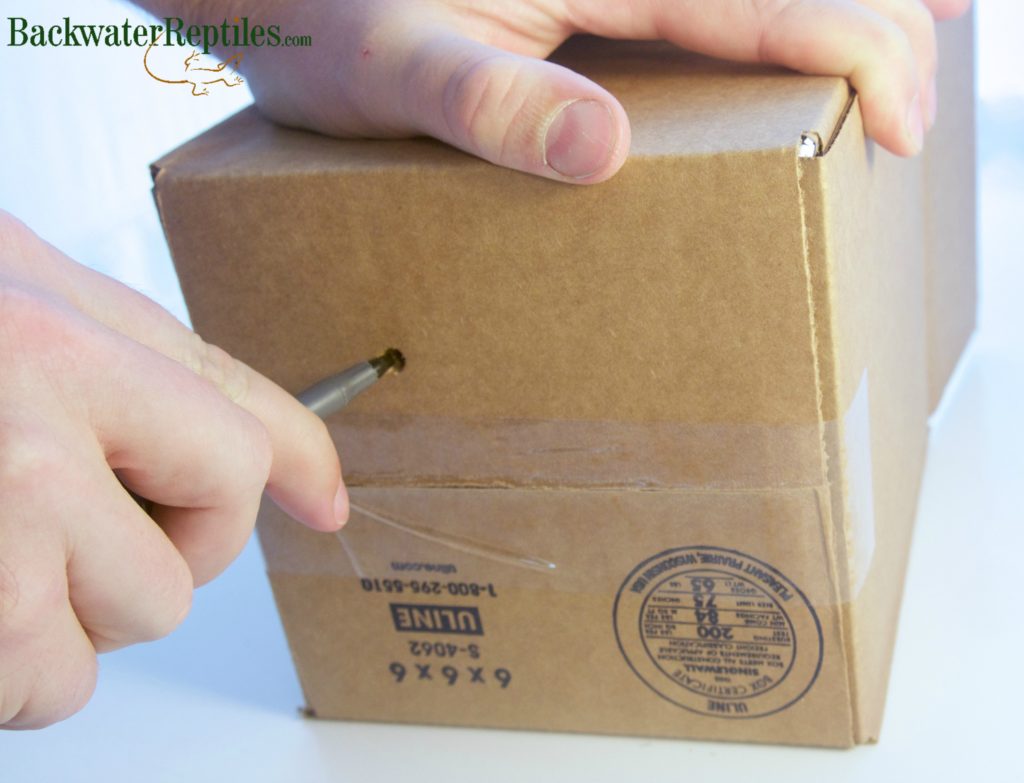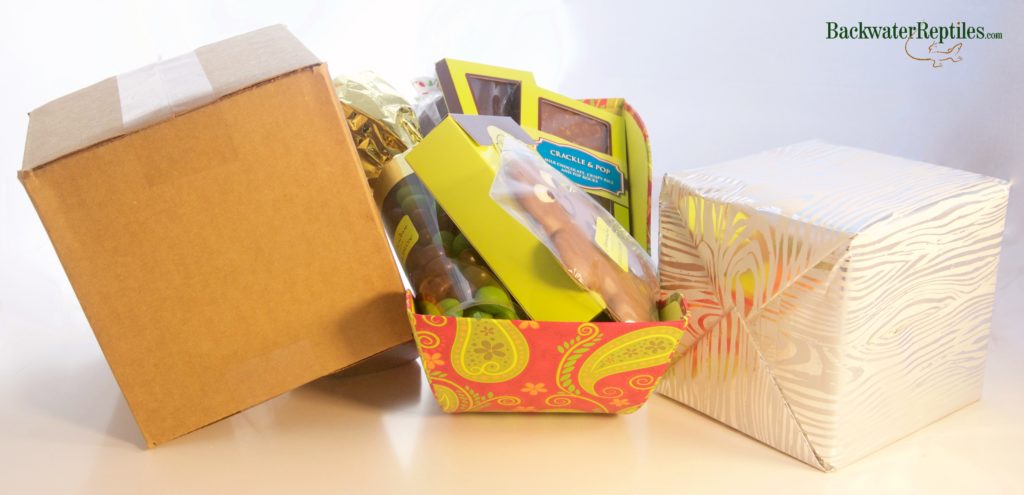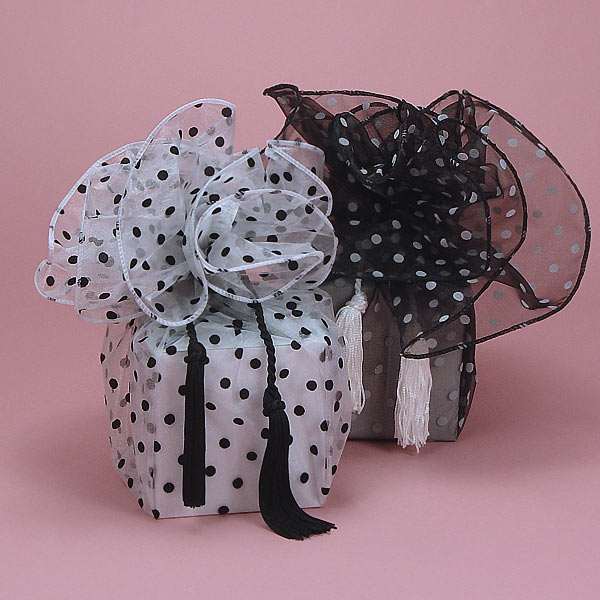If you’re wondering how to safely and humanely gift wrap a reptile, you’ve come to the right place!
We’d like to preface this tutorial article by saying that although we think reptiles and other exotic animals can make excellent gifts, we’d very much like to make it clear that you want to be one hundred percent sure that the recipient of any live animal as a gift is fully prepared to handle the responsibility of caring for a living creature.
We love all the animals we sell at Backwater Reptiles and while any one of the Backwater team would definitely love and appreciate receiving an invertebrate, reptile, or amphibian as a gift, we also know how these exotic animals need to be cared for properly.
Although many of the animals sold by Backwater Reptiles are relatively low maintenance in comparison to a pet dog or cat, they are still life long commitments and we want to include a disclaimer in this article making it known that we wish all gift givers to do their research before giving a friend, family member, or significant other a pet as a gift.
Many of the animals we sell can actually have very long life spans and taking on a new pet is not something that should be taken lightly. Again, do your research on the animal and please be sure that the recipient is fully qualified and capable of caring for it.
That being said, this article will focus on the methods we recommend for safely gift wrapping a reptile, invertebrate or amphibian.

How To Gift Wrap a Reptile
What supplies will I need to wrap a reptile, invertebrate, or amphibian?
Fortunately, wrapping up a reptile, amphibian, or invertebrate is not all that complicated. It’s actually very similar to wrapping any other gift, with a few exceptions. What this means is that you probably won’t need many special supplies. Most of the items needed you should already have around the house.
Supplies needed to gift wrap a reptile, amphibian or invertebrate:
-Scissors. This is a pretty self-explanatory tool. You’ll need to cut your wrapping paper and/or tissue paper. Regardless of whether you wrap your pet in a box or a gift bag, we pretty much guarantee you’ll need scissors at some point.
-Pen, screwdriver, or other strong, slender and pointy utensil. You’ll only need this tool if you are choosing to wrap your animal using the box method.
There are many objects you could use that you’re likely to already have handy around the house – a sturdy pen, a screw driver, or even a letter opener – but the reason you need this kind of tool is to poke air holes in the bottom or sides of the gift box. We prefer a screwdriver or pen as both are sturdy enough to poke through card board and they produce nice, solid, round holes that are appropriately sized.
-Gift bag and tissue paper OR gift box and sheer, breathable wrapping fabric or paper. Again, this is another supply that is pretty straight forward. Your wrapper of choice will largely depend on whether you wrap using a gift bag or a box.
If you use a gift bag, you will essentially only need to place the animal inside the bag with its heat pack and artfully place tissue paper to stick out of the bag to hide what’s inside.
If you prefer to wrap using a box, obviously you’ll need an appropriately sized box. We recommend using a different box than the one your critter is shipped in as the shipping box will be labelled “LIVE HARMLESS REPTILE” and sheer, breathable wrapping fabric will not hide this text.
You will likely need to purchase a special type of wrapping paper or fabric in order to successfully wrap a reptile, amphibian, or invertebrate. This is because you need to use a material that allows air to pass freely through the wrapping material. Traditional wrapping paper will block the air holes you poke in the box.
If you’re unsure what types of materials are appropriately breathable, we recommend a mesh or tulle style fabric. In fact, it might be easier to go to a fabric store and purchase the material rather than a box retail store with regular, solid wrapping paper.
-Bows, ribbons, or other decorative accessories. Once more, this item on the list of supplies needed comes down to personal preference. If you wish to add a bow to your box, you certainly can. Ribbons are also nice touches. Be as creative as you’d like!
-Packing tape or clear scotch tape. Just like wrapping any other type of gift, you’ll need clear tape to hold your box shut. You’ll also need it when adhering your wrapping material to your box. Pretty cut and dry.
When should I gift wrap my reptile, amphibian, or invertebrate?
Most people’s first question or concern when gift packaging a living creature is is it safe? In short, YES, it is indeed safe for exotic animals to be gift wrapped, so long as you don’t leave them unattended in a box for an extended period of time.

The appropriate time to wrap your pet for the recipient is the night before. For instance, if you are gifting a snake as a Christmas present, we recommend wrapping it and placing it under the tree on Christmas eve. Just make sure that no sneaky gift sleuths shake the box or bag trying to figure out what’s inside!
As long as you follow the instructions below to safely and humanely prep a reptile, amphibian, or invertebrate for gifting, you can leave the animal wrapped for an overnight time frame safely.
How to gift wrap a reptile or invertebrate
The nice thing about packaging a reptile or amphibian up into a neatly decorated little package is that they don’t require as much moisture as amphibians do. This ultimately means less hassle and far less to take into consideration when prepping your pet for the recipient.
Step One – take the reptile or amphibian out of its shipping packaging.
Your critter will arrive in a plastic cup with a lid on it with air holes. It should also contain a heat pack and the proper amount of moisture or substrate within the cup for the animal to live comfortably for a day or two.
We highly recommend taking the animal out of its shipping box and letting it “breathe” or air out in a temperature controlled environment for a few hours before wrapping it.

If you are so inclined, the animal would probably appreciate a little bit of time outside of the plastic cup as well. However, if you’re not comfortable handling the animal, it will be just fine in the cup for another day.
Step Two – poke air holes in your gift box. You can skip this step altogether if you are wrapping the animal using a gift bag.

Remember that pen, screw driver, or other sturdy tool from the supplies list? You’ll need it to poke a fair amount of air holes in your gift box. We definitely recommend poking holes in the bottom of the box, however, if you are not concerned with the aesthetic appearance of the box, you can also poke extra holes on the sides.

Step Three – wrap, wrap, wrap! Now that you’ve poked air holes, it’s time to proceed as usual. Secure your critter inside the box so that the plastic cup it arrived in doesn’t shift around, make sure the heat pack your animal was shipped with is secured inside the box, wrap your critter’s box with your sheer, breathable fabric, top with a bow, and you’re all set!
Once you’ve finished the wrapping process, we’d like to mention that unless you’ve poked holes in the sides of your box, you should prop it up at a slight angle so that the air holes aren’t directly against a flat surface. This is usually easiest when you are placing the animal under a Christmas tree. Other gifts around the oddly angled box will usually make it appear less strange.

You can use virtually anything to prop up the gift. We think other, smaller presents work great! But tissue paper, a door stop, or any other wedge-shaped object will be fine.
How to gift wrap an amphibian
You can wrap an amphibian using the same methods described above, but there is one additional aspect to take into account. Reptiles and invertebrates don’t require as much moisture as amphibians do. Amphibians need to have moisture present in their environment in order to survive, so you’ll want to be sure that there is plenty of moisture present in your amphibian’s temporary plastic carrying cup home before wrapping.
When we ship an amphibian, we will include some type of moist substrate in the shipping cup, usually wet paper towels. Paper towels tend to hold the proper amount of water and are easy to wring out if you accidentally over saturate them.

The paper towels in your amphibian’s overnight plastic cup home should be wet but not dripping. You want them to be wet to the touch but if you were to pick up the paper towel from the cup, you don’t want it to be dripping any water. If you include the proper amount of moisture, you shouldn’t have any leakage onto the pretty packaging of the wrapping material.
What species are best or easiest to gift wrap?
Overall, we think it’s easier and safer to wrap a reptile or invertebrate over an amphibian. Amphibians tend to be more delicate – they’re more sensitive to moisture changes, temperature changes, and other external stimuli.
Our top pick for the easiest reptile to gift wrap is the bearded dragon. Not only do they make fantastic pets who enjoy being handled, but they are extremely hardy and won’t mind being in a box overnight.
Most species of snakes that are commonly gifted such as corn snakes, milk snakes, boas, and pythons are also pretty tough little critters. Most snakes are content to sit calmly coiled up in their plastic shipping cup for another night and will experience no additional stress.
Scorpions and spiders are also great animals to gift wrap. Unless you specifically order a mature spider, most will arrive as tiny spiderlings and will fit nicely in cute little boxes or bags with no issues.
What if I’m not comfortable gifting a live animal?
If this article still hasn’t convinced you that gift wrapping a reptile, amphibian, or invertebrate is really not too tough of a task, then there is another option available to you if you really want to give someone a pet as a present.
Backwater Reptiles currently offers gift cards in $25 increments!
Let your gift recipient choose the exact animal they want and avoid having to wrap a critter all at the same time!
Conclusion
Again, we want to stress that gifting a living animal is not to be taken lightly. We want all the animals we ship out to go to loving homes with owners who are fully devoted to caring for the critter for the duration of its life.

Research is essential! Make sure that you are not giving someone something that they are not prepared to handle. Investigate the life span of the animal, what it eats, how large of an enclosure it will require, and any other special care requirements.
Happy reptile wrapping!
